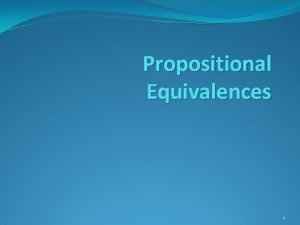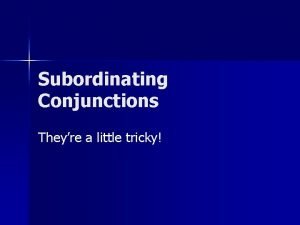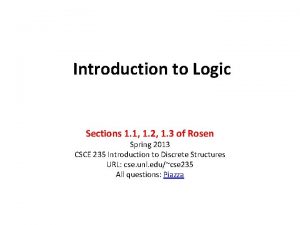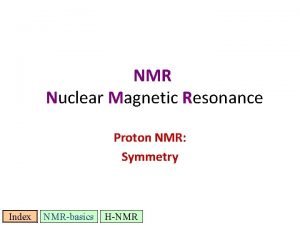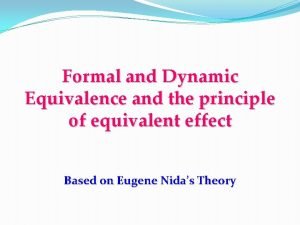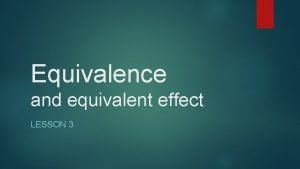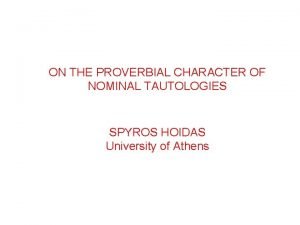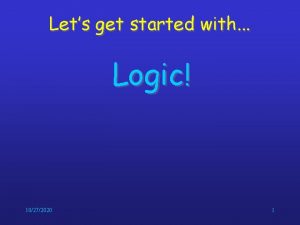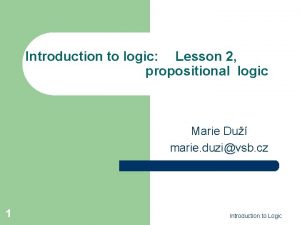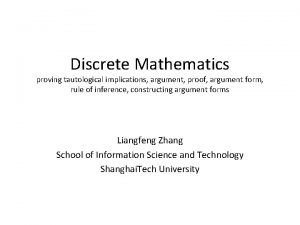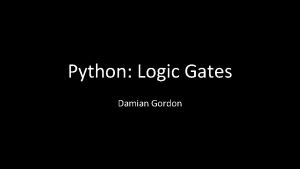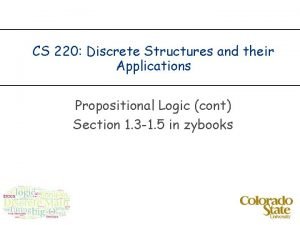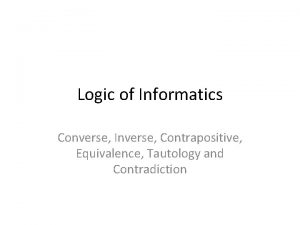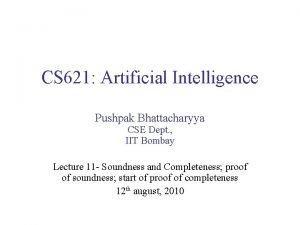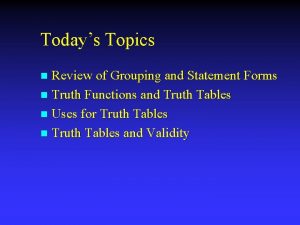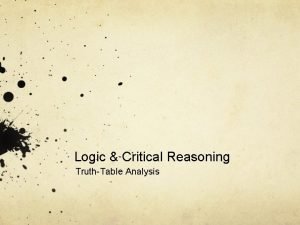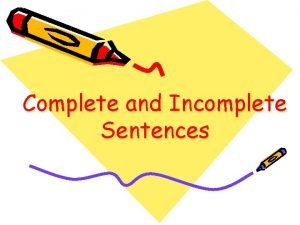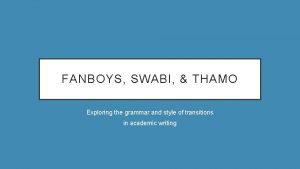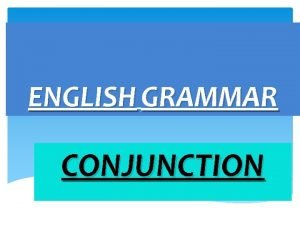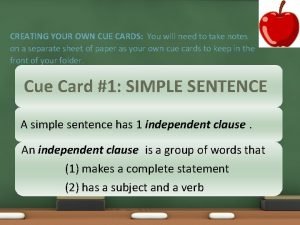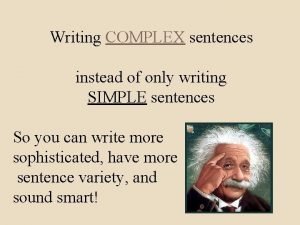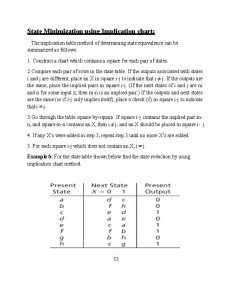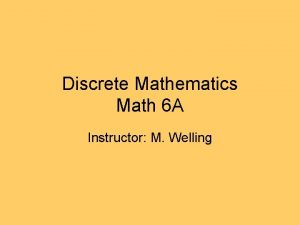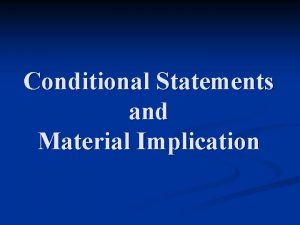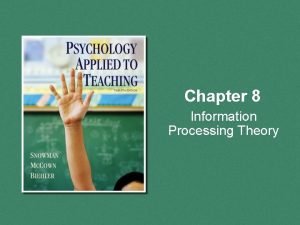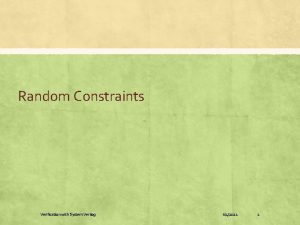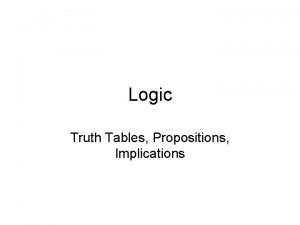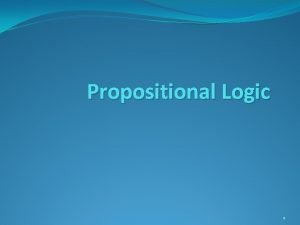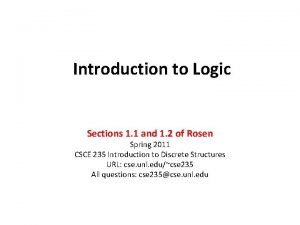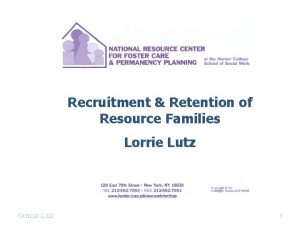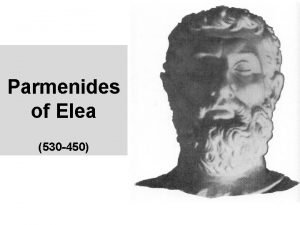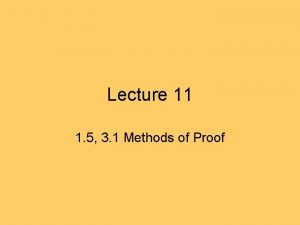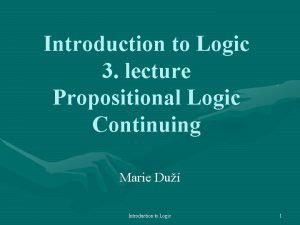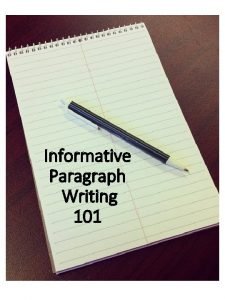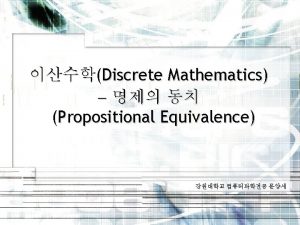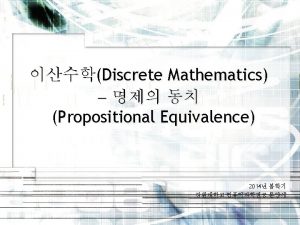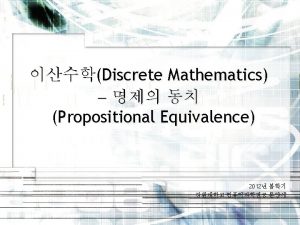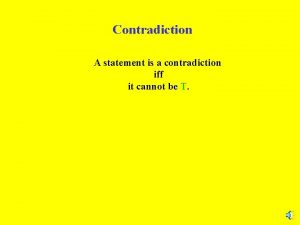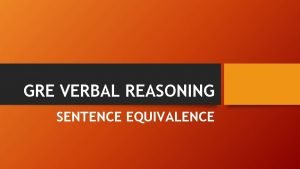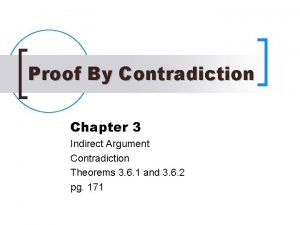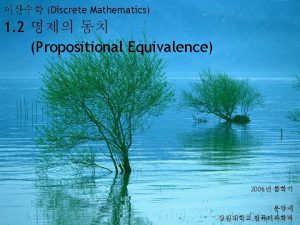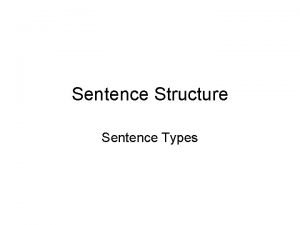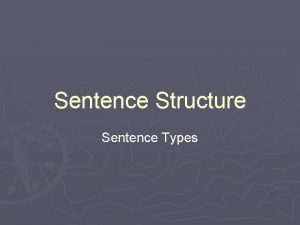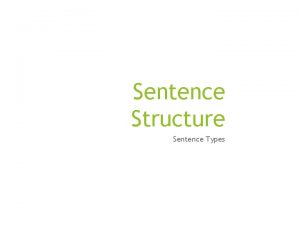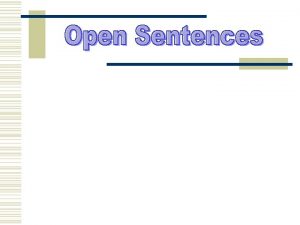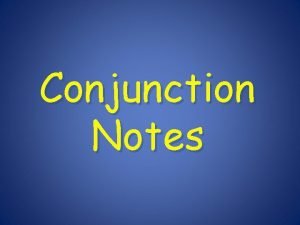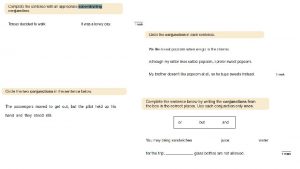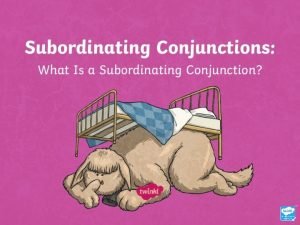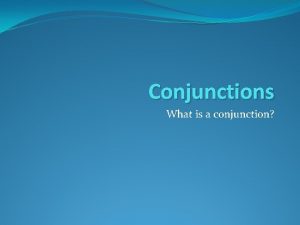CONTRADICTION CONJUNCTION TAUTOLOGY STATEMENT EQUIVALENCE IMPLICATION OPEN SENTENCE













































- Slides: 45

CONTRADICTION CONJUNCTION TAUTOLOGY STATEMENT EQUIVALENCE IMPLICATION OPEN SENTENCE PROBLEMS CONVERSE, INVERSE, CONTRAPOSITION NEGATION BIIMPLICATION QUANTIFIER DISJUNCTION LOGICAL IMPLICATION CONCLUSIONS EXCERCISE

Statement is a sentence which is only right or wrong, but can not right and wrong and the same time. Example of Statement: 1. “ 3 is a prime number ” right statement 2. “ 12 is an odd number “ wrong statement Example of Non Statement : 1. “ What is your weight? “ 2. “ For those who are sleepy, please sleep ” 3. “ Chicken noodle is delicious “

Open sentence is sentence which is contain variable so the right value can not be determined. Example open sentence : 1. “ x + y = 10 ” 2. “ It is a solid thing “ @ Open sentence can be changed into statement by changing the variable in universal set. @ Solution of open sentence is changed value in universal set which changes open sentence become right statement

From a statement can be made a new statement by adding “incorrect” word in front of the first statement or inserting “not” or ”no” in the first statement. The new statement can be found by using the method called Negation marked with . Example : Negation of p : 25 divisible by 2 is … ~p : Incorrect if 25 divisible by 2 ~p : 25 is not divisible by 2 @ If statement p is true then p is false @ If statement p is false p is true

Disjunction is statement which is formed from two statements p and q that is connected with but and notated : p q A disjunction is false if two statements are false TRUTH TABLE p q T T F F F Exercise

Conjunction is statement which is formed statements p and q that is from two connected with and/but/although/even though and notated : p q A conjunction is true if two statements are true. TRUTH TABLE p q T T F F F EXERCISE

Implication is a compound statement which is formed from two statements p and q, connected with if … then … and notated : p q An implication is false if p is true and q is false. TRUTH TABLE p q T T F T F F T EXERCISE

Bi-implication is a compound statement which is formed from two statements p and q, connected with if and only if and notated : p q A bi-implication is true if both statements have the same truth. TRUTH TABLE p q T T F F T EXERCISE

Two statement A and B are equivalence, if have the same truth, written A B These are some important equivalence: 1. Commutative Laws : 2. a. p q q p 3. b. p q q p 2. Assosiative Laws: a. p (q r) (p q) r b. p (q r) (p q) r

3. Distributive Laws: a. p (q r) (p q) (p r) b. p (q r) (p q) (p r) 4. de Morgan Laws: a. ~(p q) ~p ~q b. ~(p q) ~p ~q 5. Another equivalence statements: a. p q ~p q b. p q (~p q) (~q p) c. ~(p q) p ~q d. ~(p q) (p ~ q) (q ~p)

Tautology is a compound statements which is always true for all true possibility of its component statements. Example: Show that (p q) p is a tautology. Answer : p q (p q) p T T T F F T F T F F F T

Contradiction is a compound statements which is always false for all truth possibility of its component statement. Example : Show that (p q) ~p is a contradiction Answer : p q ~p (p q) ~p T T T F F F F F T F

Implication Logic is a tautology which is contain implication Example : Show that p (p q) is implication logic. Answer : p q p (p q) B B B S S S B

From an implication p q can be formed another implications are converse, inverse, and contraposition. If p q is an implication then: q p is called converse p q is called inverse q p is called contraposition

Example: Find converse, inverse and contraposition from statement “If is acute angle, then cos is positif”. Answer: Converse : “If cos is positive , then is acute angle” Inverse : “If is not acute angle, then cos is not positive”. Contraposition : “If cos is not positive, then is not acute angle” Implication equal with contraposition: Inverse equal with converse p q ~q ~p : ~p ~q q p

1. Universal Quantifier 2. * using all or each * 3. * notated : x S, p(x) 4. read “ for all x so p(x)” 5. 2. Existential Quantifier 6. * using some or there are/is * 7. * notated : x S, p(x) 8. read “exist x so p(x)” PROBLEMS

Negation of Quantifier Statement ~( x S, p(x)) x S, ~p(x) ~( x S, p(x)) x S, ~p(x) Example : • Negation of “ All prime number is natural number “ is “Exist a prime number is not natural number” • Negation of “Exist plant which does not have leaves” is “All plant has leaves” PROBLEMS

Three basic conclusions , are modus ponens, modus tollens and syllogism 1. Modus Ponens 2. p q (premis) 3. p 4. ----- 5. q (premis) (conclusion) PROBLEMS

2. Modus Tollens p q (premis) ---- p (conclusion) PROBLEMS

3. Syllogism p q (premis) q r (premis) ---- p r (conclusion) PROBLEMS


DISJUNCTION EXERCISES QUESTION NO. 1 Find the truth value form these disjunction ! 3 is prime number or 3 is odd. T F TO PROBLEMS MENU

DISJUNCTION EXERCISES QUESTION NO. 2 Find the truth value form these disjunction ! T sin 2 x + cos 2 x = 1 F or sin 60 = ½ TO PROBLEMS MENU

DISJUNCTION EXERCISES QUESTION NO. 3 Find the truth value form these disjunction ! T F 0 is natural number or ½ is a whole number. TO PROBLEMS MENU

DISJUNCTION EXERCISES QUESTION NO. 4 Find the truth value form these disjunction ! 13 divisible by 2 or 7 is prime number. T F TO PROBLEMS MENU

CONJUNCTION EXERCISES Find the truth value form these conjunction ! 1. sin 2 x = 1 + cos 2 x and cos 60 = ½ 2. 2 is prime number even tough 2 is even. 3. - 3 is whole number but – 3 is greater than 0. 4. 2 + 8 = 10 and log 0 = 1 TO PROBLEMS MENU

IMPLICATION EXERCISES 1. Find the truth value form these implications! 2. a. If 3 is factor of 12, then 12 is divisible by 2. 3. b. If log 10 = 1, then log 40 = 4. c. If 6 is prime number, then 6 is even. 5. d. If x 2 < 0, then x 2 + 1 > 0 6. e. If 22 x 23 = 26, then 2 x 3 = 6 7. f. If sin 90 = 0, then cos 90 = 1 8. g. If x 2 > 0, then 4 = 2 Next problems TO PROBLEMS MENU

IMPLICATION EXERCISES 2. Known these statements have true value: p : Farhan passes the exam q : Farhan is happy Find the truth value from each implication: a. If Farhan passes the exam, then he is happy b. If Farhan passes the exam, then he is unhappy c. If Farhan failed the exam, then he is happy d. If Farhan failed the exam, then he is unhappy

BI-IMPLICATION EXERCISES 1. Find the truth value form these bi-implication ! a. 0 is whole number if and only if 0 is natural number b. 2 is prime number if and only if 2 is factor of 12 c. tan 30 = 3 if and only if cos 180 = 1 d. log 8 – log 2 = log 6 if and only if log 10 = 1 e. 22 x 23 = 46 if and only if 2 + 3 = 5 f. x – 1 = 0 if and only if x 2= 0 g. x 2 – 4 < 0 if and only if -2 < x < 2 Next Problems

BI-IMPLICATION EXERCISES 2. Known these statements have true value: p : Olga is an actress q : Olga is beautiful Find the truth value from these bi-implication: a. If Olga is an actress, then she is beautiful b. If Olga is an actress, then she is not beautiful c. If Olga is not an actress, then she is beautiful d. If Olga is not an actress, then she is not beautiful TO PROBLEMS MENU

EQUIVALENCE EXERCISES Find converse, inverse, and contraposition form these implication: 1. (p q) r 2. (p ~q) r 3. p (q r) 4. If Tukul is an entertainer, then he is funny 5. If ABC is equilateral, then ABC is isosceles 6. If father goes to his office, then he rides his car or motorcycle TO PROBLEMS MENU

CONCLUSION EXERCISES Find valid or invalid of each argument: 1. If rainy then, Olga brings an umbrella Today is raining --------------------------------- Olga is bringing an umbrella 2. If Michael Jordan is a basketball player, then he is tall Michael Jordan is a basketball player --------------------------------- Michael Jordan is tall Next Exercise TO PROBLEMS MENU

CONCLUSION EXERCISES 3. If Zahra is passenger attendance, then she is beautiful If Zahra is beautiful, then many people like her ------------------------------------ If Zahra is passenger attendance, then many people like her 4. If there is sugar, then there is ants There is no ants --------------------------------- There is no sugar TO PROBLEMS MENU

DISJUNCTION EXERCISES QUESTION NO. 1 Find the truth value from these disjunction: 3 is prime number or 3 is odd. T F QUESTION NO. 2 TO PROBLEM MENU

DISJUNCTION EXERCISES QUESTION NO. 1 Find the truth value from these disjunction: 3 is prime number or 3 is odd. T F QUESTION NO. 2 TO PROBLEMS MENU

DISJUNCTION EXERCISES QUESTON NO. 2 Find the truth value from these disjunction ! sin 2 x + cos 2 x = 1 or sin 60 = ½ T F QUESTION NO. 3 TO PROBLEM MENU

DISJUNCTION EXERCISES QUESTION NO. 2 Find the truth value from these disjunction ! cos 60 = ½ or sin 60 = ½ T F QUESTION NO. 3 TO PROBLEMS MENU

DISJUNCTION EXERCISES QUESTION NO. 3 Find the truth value from these disjunction ! 0 is natural number or ½ is whole number. T S F QUESTION NO. 4 TO PROBLEMS MENU

DISJUNCTION EXERCISES QUESTION NO. 3 Find the truth value from each disjunction! 0 is natural number or ½ is whole number. T QUESTION NO. 4 TO PROBLEMS MENU F S

DISJUNCTION EXERCISES QUESTION NO. 4 Find the truth value from these disjunction ! 13 is divisible by 2 or 7 is prime number. T F TO PROBLEMS MENU

DISJUNCTION EXERCISES QUESTION NO. 4 Find the truth value from these disjunction ! 13 is divisible by 2 or 7 is prime number. T F TO PROBLEMS MENU

Good , …. You right!

Excellent, …. Y ou right!

Well done …. . !

Sorry…. . you are wrong!
 De morgan's second theorem truth table
De morgan's second theorem truth table Subordinating conjunctions list
Subordinating conjunctions list Implication law
Implication law Magnetically equivalent protons
Magnetically equivalent protons Define formal equivalence
Define formal equivalence Jakobson equivalence
Jakobson equivalence Open innovation open science open to the world
Open innovation open science open to the world Tautology examples
Tautology examples Tautology examples
Tautology examples Discrete structures
Discrete structures Well formed formula
Well formed formula Tautological implications in discrete mathematics
Tautological implications in discrete mathematics What is tautology in math
What is tautology in math Logic gates and
Logic gates and Tautology checker
Tautology checker Tttfft
Tttfft Tautology opposite
Tautology opposite Tautology
Tautology Tautology
Tautology Tautology
Tautology Example of irrelevant sentence
Example of irrelevant sentence Complete and incomplete sentences examples
Complete and incomplete sentences examples Thamo grammar
Thamo grammar What is a conjunction word
What is a conjunction word Funny simple sentences
Funny simple sentences What is awubis
What is awubis Implications table
Implications table Implication elimination
Implication elimination Symbols of negation
Symbols of negation Mathmatical proposition
Mathmatical proposition Material implication examples
Material implication examples Teaching implication of the information process
Teaching implication of the information process Verilog urandom
Verilog urandom Truth table of implication
Truth table of implication Disjunction
Disjunction De morgan's laws logic
De morgan's laws logic Proposition examples sentences
Proposition examples sentences Implication for practice
Implication for practice Proof by contradiction examples
Proof by contradiction examples 530+450
530+450 Nonfiction notice and note
Nonfiction notice and note Proof by contradiction examples
Proof by contradiction examples Meetup background
Meetup background Contradiction formula
Contradiction formula Informative paragraph
Informative paragraph Proof of contradiction
Proof of contradiction
